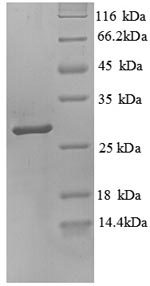To make this Recombinant Human PRSS3 protein, the PRSS3 gene was isolated at first and cloned into an expression vector. CUSABIO has built a mature recombinant protein platform. This Recombinant Human PRSS3 protein was developed in the platform. It was expressed in E.coli at the region of 81-303aa of the Human PRSS3 protein. N-terminal 6xHis tag was fused with the expression vector for affinity and purification purposes. The purity is 90%+ determined by SDS-PAGE.
Serine protease 3 (PRSS3), one of the three major isoforms of trypsinogen, is a serine protease that is synthesized mainly in pancreatic acinar cells. It can be secreted into the small intestine to promote digestion. As a member of the serine protease family, PRSS3 is highly homologous to trypsinogen I and II (PRSS1 and PRSS2) at both the gene and protein levels. However, unlike PRSS1 and PRSS2, a small portion of pancreatic exocrine secretions is composed of PRSS3, which accounts for 3.0–10% of the trypsinogen content in normal pancreatic juice. The tumor specificity of trypsinogen has been elucidated in many types of tumors and it is thought to be involved in the development and progression of malignancies. PRSS3 is expressed in the airway epithelium and its active trypsin is detected in the lung bronchial epithelium, which might be related to its ability to activate various proteases in relation to coagulation, fibrinolysis, and/or inflammation. In non-small–cell lung cancer (NSCLC), the expression of PRSS3 is closely associated with metastasis and with a low prognosis for NSCLC patients. In addition, overexpression of PRSS3 in lung-cancer tissue results in increased migration across endothelial cells, thereby highlighting the potential role of trypsin in tumor metastasis. Taken together, PRSS3 plays an important role in the development and progression of many types of malignant tumors.






